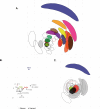Neutralizing antibody activity against 21 SARS-CoV-2 variants in older adults vaccinated with BNT162b2
- PMID: 35836002
- PMCID: PMC9352594
- DOI: 10.1038/s41564-022-01163-3
Neutralizing antibody activity against 21 SARS-CoV-2 variants in older adults vaccinated with BNT162b2
Abstract
SARS-CoV-2 variants may threaten the effectiveness of vaccines and antivirals to mitigate serious COVID-19 disease. This is of most concern in clinically vulnerable groups such as older adults. We analysed 72 sera samples from 37 individuals, aged 70-89 years, vaccinated with two doses of BNT162b2 (Pfizer-BioNTech) 3 weeks apart, for neutralizing antibody responses to wildtype SARS-CoV-2. Between 3 and 20 weeks after the second vaccine dose, neutralizing antibody titres fell 4.9-fold to a median titre of 21.3 (neutralization dose 80%), with 21.6% of individuals having no detectable neutralizing antibodies at the later time point. Next, we examined neutralization of 21 distinct SARS-CoV-2 variant spike proteins with these sera, and confirmed substantial antigenic escape, especially for the Omicron (B.1.1.529, BA.1/BA.2), Beta (B.1.351), Delta (B.1.617.2), Theta (P.3), C.1.2 and B.1.638 spike variants. By combining pseudotype neutralization with specific receptor-binding domain (RBD) enzyme-linked immunosorbent assays, we showed that changes to position 484 in the spike RBD were mainly responsible for SARS-CoV-2 neutralizing antibody escape. Nineteen sera from the same individuals boosted with a third dose of BNT162b2 contained higher neutralizing antibody titres, providing cross-protection against Omicron BA.1 and BA.2. Despite SARS-CoV-2 immunity waning over time in older adults, booster vaccines can elicit broad neutralizing antibodies against a large number of SARS-CoV-2 variants in this clinically vulnerable cohort.
© 2022. The Author(s).
Conflict of interest statement
The authors declare no competing interests.
Figures








Comment in
-
COVID vaccination in older adults.Nat Microbiol. 2022 Aug;7(8):1106-1107. doi: 10.1038/s41564-022-01166-0. Nat Microbiol. 2022. PMID: 35836001 No abstract available.
References
-
- Konings, F. et al. SARS-CoV-2 variants of interest and concern naming scheme conducive for global discourse. Nat. Microbiol.6, 821–823 (2021). - PubMed
Publication types
MeSH terms
Substances
Supplementary concepts
Grants and funding
- MR/W005611/1/MRC_/Medical Research Council/United Kingdom
- BB/T008784/1/BB_/Biotechnology and Biological Sciences Research Council/United Kingdom
- BBS/E/I/COV07001/BB_/Biotechnology and Biological Sciences Research Council/United Kingdom
- BBS/E/I/00007031/BB_/Biotechnology and Biological Sciences Research Council/United Kingdom
- BBS/E/I/00007038/BB_/Biotechnology and Biological Sciences Research Council/United Kingdom
LinkOut - more resources
Full Text Sources
Other Literature Sources
Medical
Miscellaneous

